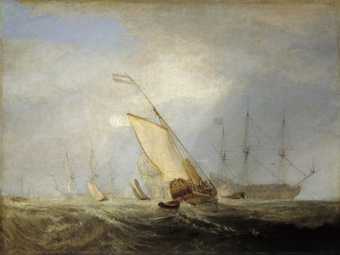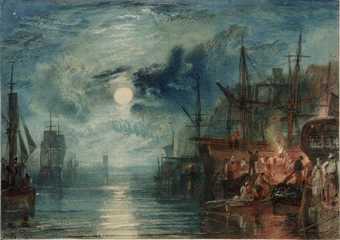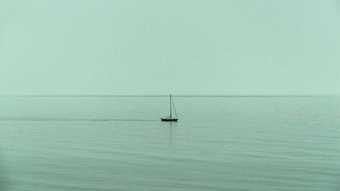
Joseph Mallord William Turner
Van Tromp Returning after the Battle off the Dogger Bank
(exhibited 1833)
Tate
JMW Turner
Joseph Mallord William Turner (1775–1851) painted the sea more than any other subject, in his uniquely atmospheric style that often showed the extreme danger of the waters. His fascination with the sea encompassed ships and boats of all sizes and uses, often struggling amid powerful storms and menacing dark skies. Throughout his life, Turner regularly travelled to find inspiration, always carrying a sketchbook with him to record anything that caught his attention, which might later be developed into a watercolour or oil painting. The politics and social conditions of the time also informed Turner’s work. He lived through a period of significant change and upheaval, as the British Empire battled its colonial rivals, and the beginnings of the Industrial Revolution took shape. These events would inform his work, revealing the ocean as a place of industry and warfare alongside the serenity and ferocity of the ever-changing weather conditions.
Here, the full range of Turner’s creative process can be experienced within an immersive sound environment from artist and musician Lamin Fofana (born 1982). Fofana similarly looks toward the sea, particularly the Atlantic Ocean, and its relationship to power, industry and tragedy, mortality and loss. Through his work, Fofana connects the sea’s overlapping histories and how it has shaped and defined the perilous journeys of enslaved people, migrants and refugees from Africa and the Middle East across the Mediterranean and the Atlantic.
Lamin Fofana
For this exhibition, Lamin Fofana presents two audio installations, Resounding Water 2022, which plays in this room, and Life and Death by Water 2021, playing in the next space. With his work, Fofana often aims to transmute important texts from Black authors into sound. Here, he looks toward Darkwater: Voices from within the Veil by the African American writer and activist WEB Du Bois. Published in 1920, the book is a collection of autobiographical essays, poetic fragments and allegories that interrogate white supremacy, patriarchy, capitalism, and how these forces interlink. The other key source is Zong! As Told to the author by Setaey Adamu Boateng 2008, a book-length poem from M NourbeSe Philip, which recalls the legal battle following the murder of over 130 enslaved Africans on the slave ship the Zong in 1781.
With both Resounding Water and Life and Death by Water, Fofana creates minimal compositions that include field recordings taken in Liverpool, as well as Freetown, Sierra Leone; New York, US; and Berlin, Germany. Through this, Fofana links Europe with West Africa and North America, tracing the triangular trading route of the Atlantic slave trade. Life and Death by Water also includes a hummed melody from Rivers of Babylon, the 1970 reggae song by The Melodians. The song is based on the Biblical psalm 137:1–4, lamenting the exile of the Jewish people following the Babylonian conquest of Jerusalem. As such, it is an apt allegory for enslaved people, refugees, migrants, and other displaced people throughout history.
Dutch Influence
Dutch marine art was an important influence on Turner throughout his career. In the seventeenth century Netherlands, seascapes developed into a genre in their own right, rather than a minor extension of landscape painting. High profile Dutch artists such as Willem van de Velde moved to London to further their careers, and maritime images were extremely popular in Britain by the time of Turner’s youth.
Marine painting reflected the importance of the sea to Dutch society. During the seventeenth century, the Netherlands became one of the leading powers in Europe, through maritime trade and naval power. The Dutch East and West India Companies helped to establish an empire across coastal territories in the Americas, southern Africa and southeast Asia. Dutch ships accounted for around five per cent of the Atlantic slave trade, while slavery was also commonplace in their African and Asian colonies.
Britain was a rival of the Netherlands during the seventeenth and eighteenth centuries, and the countries went to war four times during this period. The British Empire was growing, as was the British share of the slave trade, and the two nations fought over trade routes and colonial territories. Turner’s painting Van Tromp Returning after the Battle off the Dogger Bank depicts a scene from the Fourth Anglo-Dutch War, showing strong Dutch influence in the style and content, despite Britain’s ultimate victory over the Netherlands in the war.
Disasters at Sea

Joseph Mallord William Turner
Stormy Sea with Dolphins
(c.1835–40)
Tate
Turner was well aware of the dangers of the sea, from extreme weather conditions to naval battles and other maritime disasters. He depicted many such scenes in his work, with the Zong massacre providing inspiration for both him and Lamin Fofana. It has informed Fofana’s sound installations in this exhibition, while Turner painted a scene inspired by the event in one of his most celebrated works, Slave Ship (Slavers Throwing Overboard the Dead and Dying, Typhoon Coming On) 1840, which is in the collection of the Museum of Fine Arts Boston.
The massacre took place in 1781, when the crew of the Zong murdered over 130 enslaved people, throwing them overboard into the Caribbean Sea. The ship was owned by a group of Liverpool merchants led by William Gregson, who served as the Lord Mayor of Liverpool in 1762. He was responsible for more than 150 slaving voyages, transporting approximately 58,000 Africans, over 9,000 of whom died at sea. Gregson Street in Everton is named after him.
The killing on the Zong took place when the ship ran low on drinking water, according to the claims of the crew. Enslaved people were insured as cargo, so an insurance claim could be made if they were thrown overboard to preserve the ship. A resulting legal case between the Zong’s owners and the insurance company drew attention to the event, and it became an important to the abolitionist movement as an example of the horrors of slavery.
Sea, Light and Colour
The sea inspired some of Turner’s most audacious and experimental watercolour studies, drawings, and sketchbooks. These show how he could capture water and light with just a few strokes of colour. Discovered among the contents of Turner’s studio upon his death, these sketches were made during a lifetime of travel and proximity to the shore. Both uplifting and threatening, the studies shown here foreground the radically innovative nature of Turner’s approach to depicting the sea. Explosive scenes render storms and figures in expressive graphite and ink. His inks and watercolours agitate and animate, demarcating capsized boats and the dramas of thundering skies or reducing sunsets to horizontal bands of luminescent gouache. Carrying these techniques through to his fully realised paintings, critics at the time were often mystified and outraged by Turner’s work.
Because his subjects are not always clearly recognisable, Turner’s works are often described are abstract, but his intent was to accurately capture the sensation of being among these conditions. These works on paper provide a fuller picture of Turner as an experimental artist pushing the boundaries of representation.
JMW Turner with Lamin Fofana: Dark Waters is at Tate Liverpool from 27 September 2022 – 24 September 2023.



